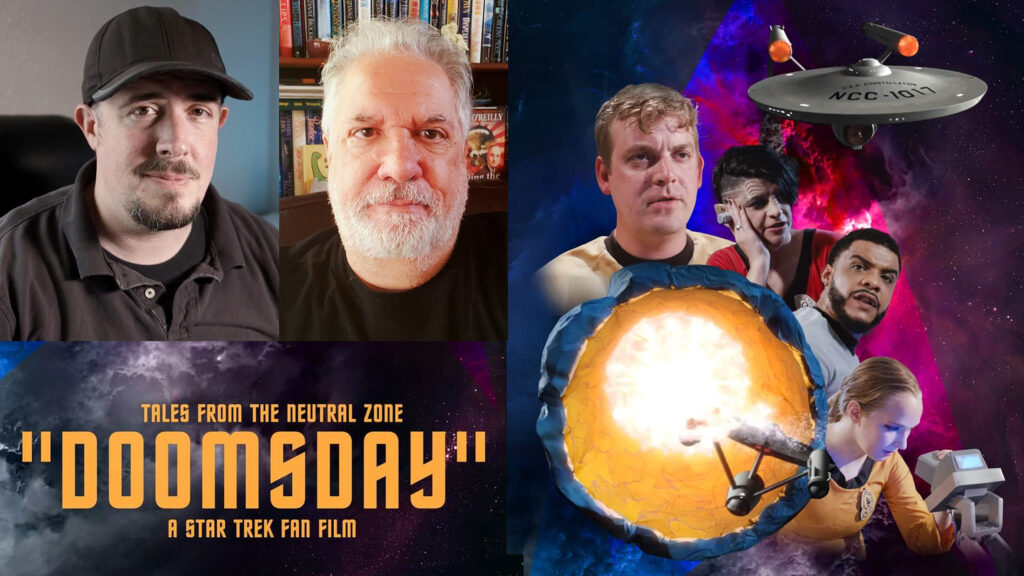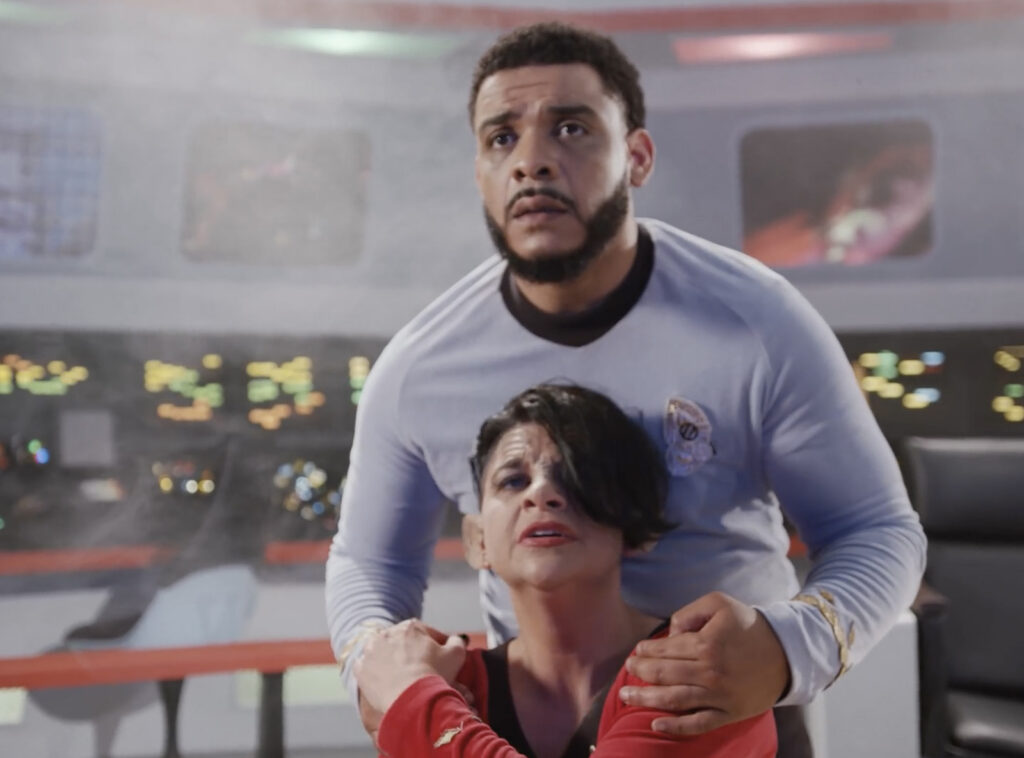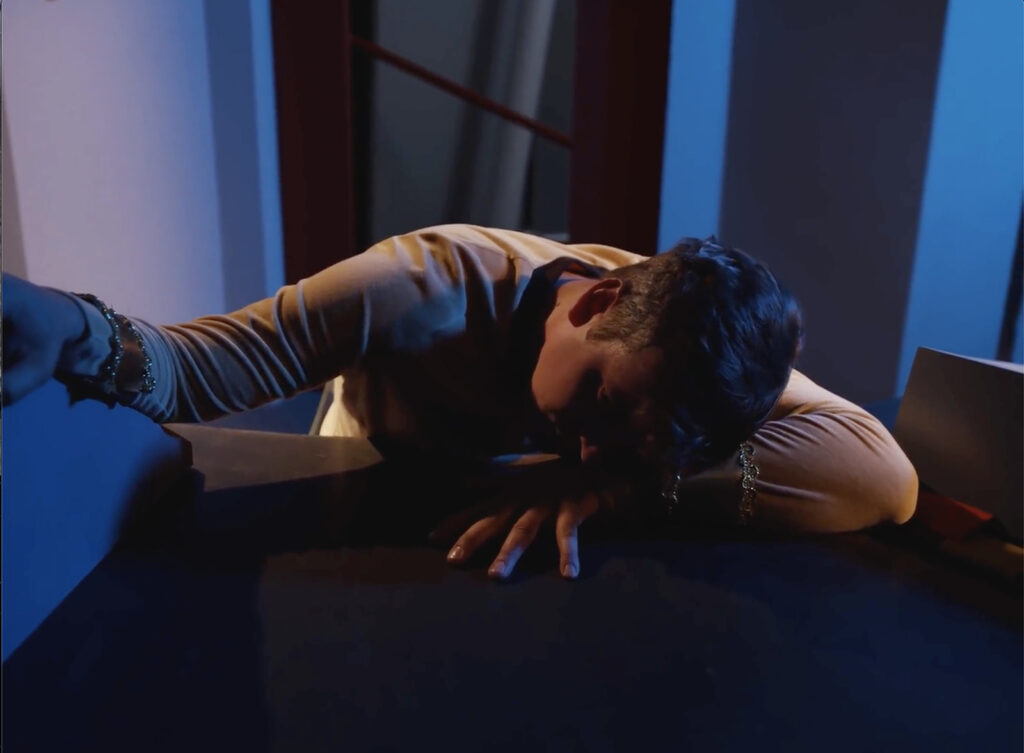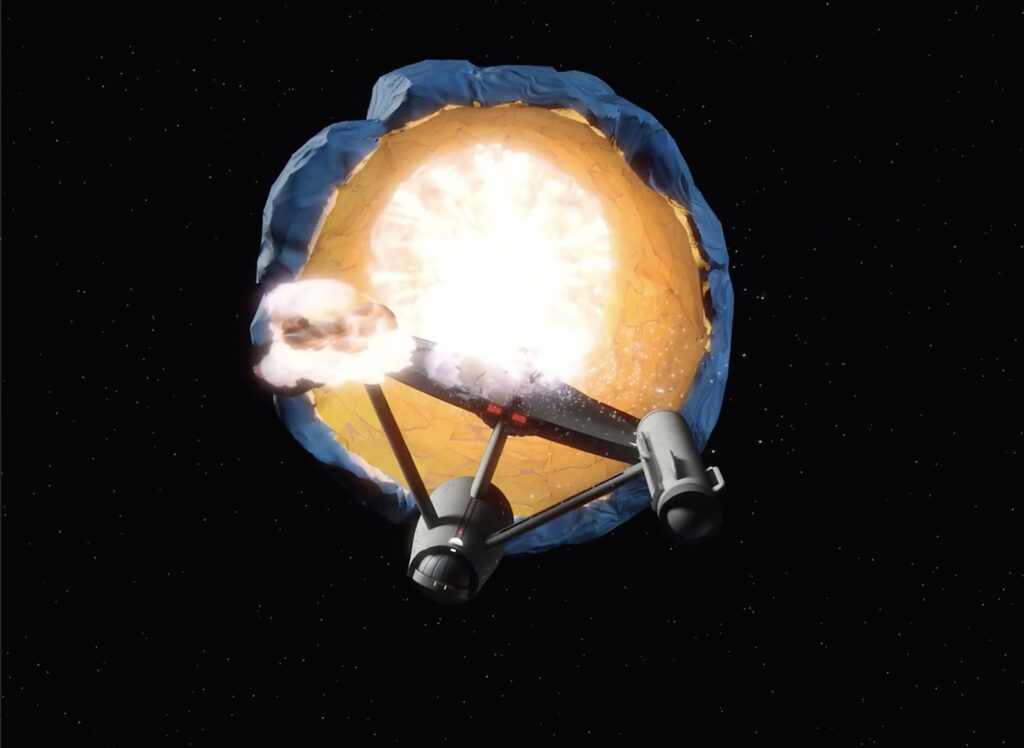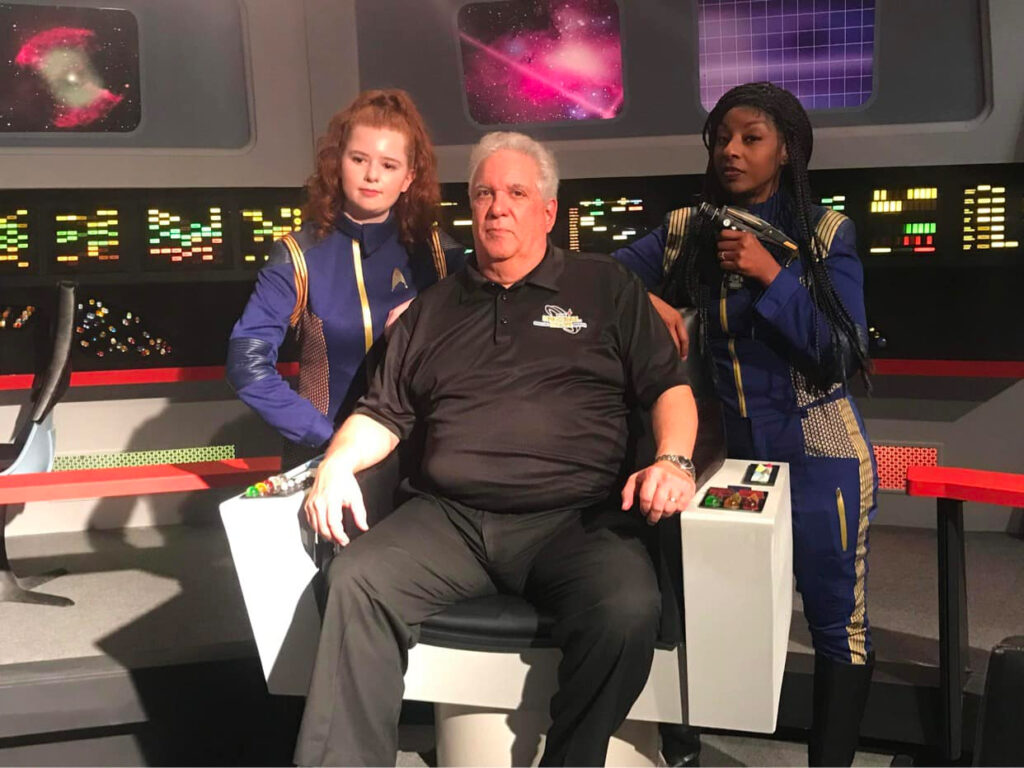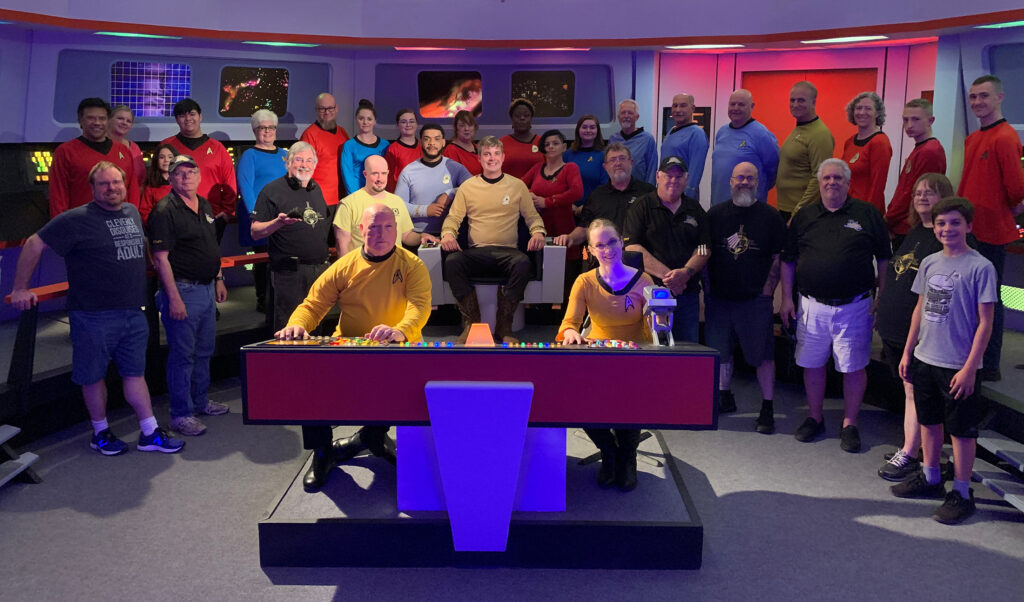Last week in Part 1, we learned how, in March of 2021, RAY TESI from NEUTRAL ZONE STUDIOS had asked JOSHUA IRWIN from THE AVALON UNIVERSE to make the half-day drive from northeastern Arkansas to southeastern Georgia to be the director of photography for the newest TALES FROM THE NEUTRAL ZONE fanthology film “DOOMSDAY.” Josh was happy to help out, and the completed production has quickly become the most watched of all three of the Neutral Zone releases, nearly doubling the views of the previous two offerings, THE LOOKING GLASS (released in June of 2019) and ENDOSYMBIOSIS (February 2021) in only a couple of weeks.
Take a look…
We had just learned that, after arriving at the studio on the day of shooting, Ray had gotten buried under other studio-related tasks he needed to do. And so he asked Josh if he would mind taking over as director in addition to being director of photography (two VERY different jobs). Josh is used to dealing with the unexpected on film sets, working in the film industry himself professionally, and so he agreed to the challenge.
Of course, this gave Josh essentially no time to prepare as director, and so I asked him the following question…
JONATHAN – What do you think you would have done differently if you’d known in advance that you were going to direct?
JOSH – I think I would’ve taken more time to break down the script…
JONATHAN – What does that mean, precisely, to “break down the script”?
JOSH – Essentially to
- Figure out what it’s about…there’s usually a deeper meaning to the writer’s intent.
- You want to know who the characters are and figure out why they do the things that they do.
- You want to give thought to how the shots you plan to take illustrate what those characters do.
If there were really anything that I wish we had done differently, I would have wanted to get more into getting to know the crew of the Constellation because I feel like, if you’re going to care about the fact that these people died, it would mean more if you knew them. It might have been fun to see some facets of their personal life or see what these people meant to Decker so their deaths would have carried a little more weight.
JONATHAN – But isn’t that more what a writer would do? Doesn’t the director work from the completed script?
JOSH – Well, in this hypothetical scenario, I’ve gotten involved earlier in the process. And it just depends on what people are open to. Sometimes you can go to a writer with suggestions, and they might be cool with doing a couple of rewrites.
JONATHAN – Well, that was true with me as a writer. I remember that VICTORIA FOX, who directed INTERLUDE, suggested a few script changes early on that made the film even better, in my opinion.
So is there anything else you would have done differently had you been brought in sooner as director?
JOSH – In this case, you want people to believe that this took place right before “The Doomsday Machine.” So one of the motivations that I had is that I wanted to try to make it look as much like “The Doomsday Machine” as possible. And I think, if I had it to do over again, I might have thrown in some things like a wide shot of everyone falling out of their chairs like they used to do on TOS when the Enterprise gets hit. That might have been funny. There were some pick-up shots that I asked them to film after I went back to Arkansas, but if I had a chance to do it over, I would have filmed those shots myself because you can tell the difference.
But mostly, I think I would have spent time putting together a more cohesive plan. I mean, there’s always going to be wrinkles in any plan, but I would have worked harder to try to figure out what the overall approach would be instead of just winging it.
Keep in mind, though, that I did do quite a lot of preparation as director of photography. I gave a lot of thought to the overall look of the film visually: trying to light it like “The Doomsday Machine,” and I made the decision and ran it by Ray—and he liked the idea—of shooting it 4×3 like STAR TREK CONTINUES did. Unlike Avalon, where we’re trying to make it look different and shooting cinemascope and using LED lights, and all of that stuff, doing something like this you are trying to be throwback and look canon. So instead, we’re shooting with incandescent lights and desensitizing the camera, and shooting 4×3. And at the end, I put a bunch of film grain on it and dirt and increased the contrast and just little fun things to make it look like it was shot on old 35mm film back in the 60s.
JONATHAN – Let’s move on to post-production. I know that Josh was the film editor. Ray, did you supervise him at all or just let Josh do that voodoo that he do so well?
RAY – I pretty much stayed on the sidelines for post-production. That was mainly Josh.
JOSH – Yeah, Ray for the most part was extremely happy with the cuts that I was doing. I’d show him a cut, and he’d be like, “Oh, I think that’s great!” And then I’d be like, “Yeah, I’m not really happy with it. I want to go work on it some more.” And he’s asking, “What could you possibly do to make it better?” because he liked it. Then I would go and work on it for another 25 hours and do two more extensive passes on it and show it to him, and he’d be like, “Wow, I thought you couldn’t make it better, but you did! I really like it.”
RAY – That’s pretty much what happened. But eventually, I needed to stop Mr. Perfectionist here for his own sake.”
JOSH – Yeah, I think after about the fifth time I did that, Ray called me up and said, “Hey, Cecil B. DeMille, it’s good enough. You don’t have to keep sweatin’ over this.”
JONATHAN – So did you stop sweating over it after that?
JOSH – No.
JONATHAN – Seriously???
JOSH – Yeah. because there were a lot of things I still wanted to do. In fact, that was when I asked Ray if we could do pick-up shots. I’d be going back down there, and I was thinking if we could reassemble the bridge crew, I could shoot that falling-out-of-the-chair shot and and bunch of other pick-ups.
JONATHAN – And what did Ray say to that?
RAY – I said “no.”
JOSH – Yeah, Ray said we’d wasted enough time on this movie; it’s time to move on to the next one. And frankly, my wife was saying that same kind of stuff to me. She was like, “It’s time to put the paintbrush down now. You’re obsessing over this.” But I was having fun working on it, and I just wanted it to be cool.
JONATHAN – So how long did you work on the edit in total, Josh?
JOSH – All told, I think it was one and a half, maybe two months of weekends…plus maybe a couple of nights during the week working for four hours at a time.
JONATHAN – And all day on the weekends?
JOSH – Pretty much, yeah. I would just close the door and work on it through the two days of the weekend. It definitely took me longer than I thought it would.
JONATHAN – Doomsday has now gotten twice as many YouTube views than the previous two Tales from the Neutral Zone releases combined. Are you surprised at that? And why do you think this particular fan film is doing so well?
RAY – I’m surprised not only at the views, but at the number of overwhelmingly positive comments. I can only attribute it to the subject matter. “The Doomsday Machine” is regarded as one of the top TOS episodes, and it’s been making its comeback through fan films. It certainly seems to resonate with fans!
JOSH – I agree. I’ll add that I think people people are hungry for simple, classic TOS-style stories. The comment we get the most in fan films is that people are turning to fan films, oddly enough, to get the classic adventure-style Star Trek that they feel they don’t get these days from CBS.
I think Doomsday is an interesting story that fans have always wanted to see. They just see that thumbnail, and boom, there’s a Constitution-class and a Doomsday Machine, and hey, we all like “The Doomsday Machine.” It’s one of the most popular episodes of the original series. So people click on it. It’s short enough so that people aren’t going to get bored. There’s constant action, they like the story, so they watch it longer. And that feeds the YouTube algorithm and tells the algorithm to show it to more people. So I think it’s mainly that Doomsday is a a short, simple, TOS-style adventure story that tries to be true what inspired it, and I think people appreciate that.
JONATHAN – What’s coming next from Tales of the Neutral Zone?
RAY – We filmed our next fan film back in February titled DUTY CALLS, a TOS/DISCOVERY crossover that is now in post production. At our November 2021 Fan Appreciation Weekend, we had two young ladies cosplaying as Burnham and Tilly—and they were perfect, so I told them I needed to put them in a fan film, so I did!
We will also be crowd-funding shortly for the fan film THE TEST OF TIME, which Josh is also a part of as DP. It’s going to be more aggressive than the films we’ve done so far. It will be a time-traveling adventure with a twist ending. We already shot some test footage, and it looks great!
JONATHAN – Any final thoughts to share?
RAY – I’m thrilled to see that fan films are on an upswing and that more and more are being released constantly…and that Neutral Zone Studios figures into many of them. And I have to add that I’m thrilled at my friendship with both Joshua Irwin and SAMUEL COCKINGS (who does our VFX) because without them, The Neutral Zone wouldn’t be The Neutral Zone.
JOSH – What I enjoyed the most was the people that I got to work with. The volunteers at Neutral Zone are a very good group of people. They like being there. They’re very fun to be around—guys like DAN SCANLAN, ALLEN ANDERSON, DREW SANFORD, SAM ROOKS—just really dedicated people that work hard, and they show up there all the time to make fan films…whether it’s Tales from the Neutral Zone or Avalon or Dreadnought Dominion. They’re there because they want to be there.
One actor, LUIS SANCHEZ, who played Masada, who was absolutely wonderful. He was on top of it the whole time. He knew his stuff, he did a wonderful job, and he’s going to be back playing another character in an upcoming Tales from the Neutral Zone. We’ve already filmed it, and he did a magnificent job. Luis, Matt, Sarah, everyone who volunteered their time to be there and try to make a cool film, it was a really neat experience.
JONATHAN – That’s the heart of what fan films are.
JOSH – It really was! This was a situation where people were there just because they really loved Star Trek, and they wanted to be in a Star Trek movie. They wanted to show up on the sets and put on the uniforms and play Star Trek for a day and be a part of that world. There was a lot of passion involved in that. I mean, in what other situation are you going to go into a building that’s 100 degrees with no air conditioning and put on long-sleeve shirts and long pants???
People were doing it because they loved it, and you could tell hey loved it, and that’s what made it so special and made me want to do it again.

